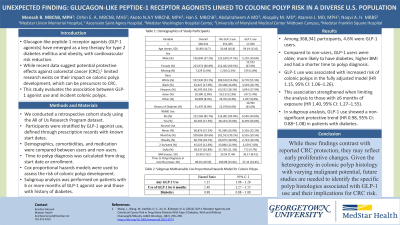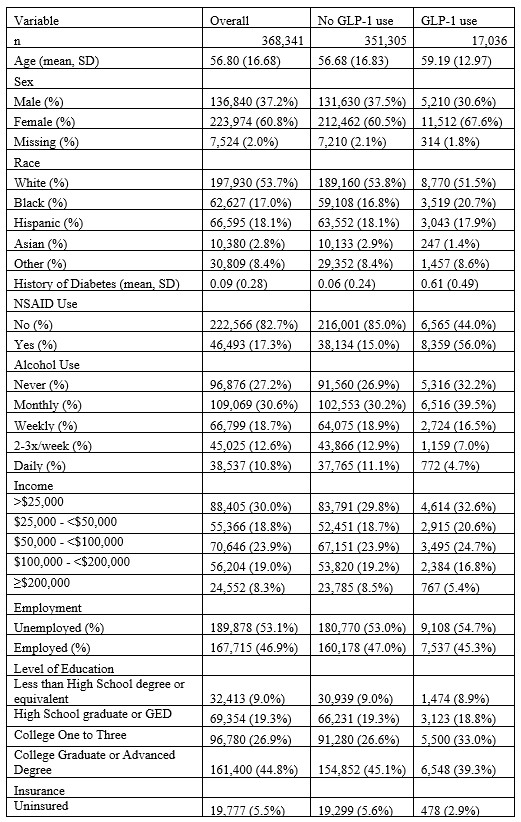Tuesday Poster Session
Category: Colon
P4569 - Unexpected Findings: GLP-1 Agonist Use Linked to Increased Colonic Polyp Risk in a Diverse U.S. Population

.jpg)
Boniface Mensah, MBChB, MPh
MedStar Georgetown University Hospital
Baltimore, MD
Presenting Author(s)
1MedStar Georgetown University Hospital, Baltimore, MD; 2Ascension Saint Agnes Hospital, Baltimore, MD; 3MedStar Washington Hospital Center-Georgetown University, Washington, DC; 4University of Maryland Medical Center Midtown Campus, Baltimore, MD; 5MedStar Franklin Square Medical Center, Baltimore, MD
Introduction:
Glucagon-like peptide-1 receptor agonists (GLP-1 agonists) have emerged as a key therapy for type 2 diabetes mellitus and obesity, with additional benefits in cardiovascular risk reduction. While recent data suggest potential protective effects against colorectal cancer (CRC), limited research exists on their impact on colonic polyp development, which can be precursors to CRC. This study evaluates the association between GLP-1 agonist use and incident colonic polyps.
Methods: We conducted a retrospective cohort study using the All of Us Research Program dataset. Participants (N=368,341) were stratified by GLP-1 agonist use, defined through prescription records with known start dates. Demographics, comorbidities, and medication were compared between users and non-users. Time to polyp diagnosis was calculated from drug start date or enrollment, whichever came first. Cox proportional hazards models were used to assess the risk of colonic polyp development, adjusting for age, sex, race/ethnicity, BMI, alcohol and NSAID use, smoking history, and diabetes status. A subgroup analysis was performed on patients with 6 or more months of GLP-1 agonist use and those with history of diabetes.
Results:
Among 368,341 participants, 17,036 (4.6%) were GLP-1 users. Compared to non-users, GLP-1 users were older (59.2 vs 56.7 years, p< 0.001), more likely to have diabetes (61% vs 6%, p< 0.001), and had higher BMI (36.2 vs 29.6, p< 0.001). They also had a shorter time to polyp diagnosis (37.3 vs 101.0 months, p< 0.001). GLP-1 use was associated with increased risk of colonic polyps in the fully adjusted model (HR 1.15, 95% CI: 1.06–1.26). This association strengthened when limiting the analysis to those with ≥6 months of exposure (HR 1.40, 95% CI: 1.27–1.55). In diabetic-only subgroup analysis, GLP-1 use showed a non-significant protective trend (HR 0.98, 95% CI: 0.88–1.08). Other significant predictors included age, BMI, alcohol use, NSAID use, and diabetes.
Discussion:
In this large, diverse cohort, GLP-1 agonist use was independently associated with a higher risk of colonic polyp development, particularly with prolonged exposure. While these findings contrast with reported CRC protection, they may reflect early proliferative changes. Given the heterogeneity in colonic polyp histology and their varying malignant potential, future studies are needed to identify the specific polyp histologies associated with GLP-1 use and their implications for colorectal cancer risk.


Disclosures:
Boniface Mensah, MBChB, MPh1, Albert E.. Orhin, MBChB, MHS2, Natalie A.Y.. Akoto, MBChB, MPH1, Seunghee Han, MBChB1, Ahmad Abdulraheem, MD3, Mohammed Aloqaily, MD4, Joseph Atarere, MD1, Haider A. Naqvi, MD5. P4569 - Unexpected Findings: GLP-1 Agonist Use Linked to Increased Colonic Polyp Risk in a Diverse U.S. Population, ACG 2025 Annual Scientific Meeting Abstracts. Phoenix, AZ: American College of Gastroenterology.
